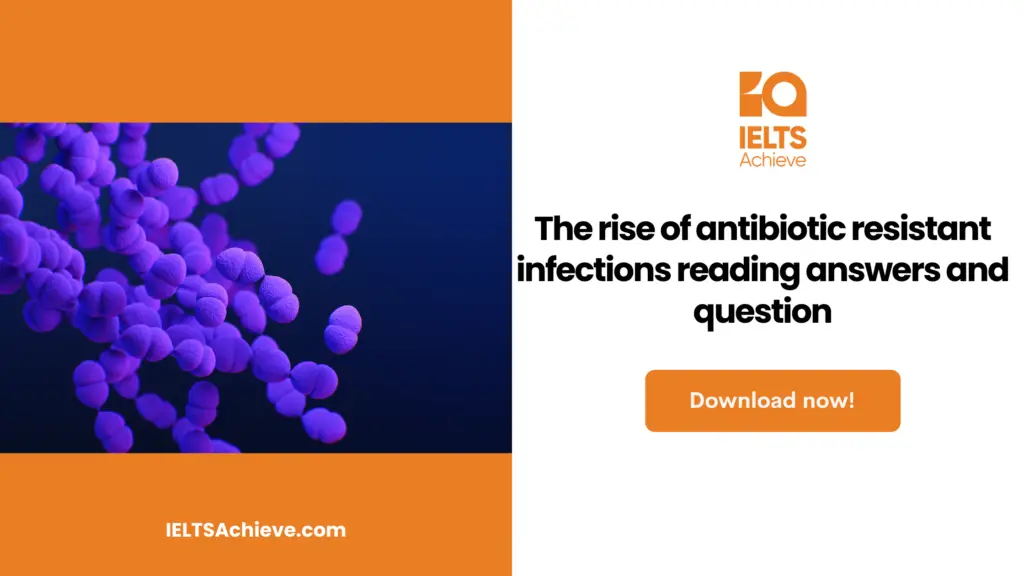The Blog post contains the following IELTS Reading Questions:
- IELTS reading matching heading.
Stay informed and prepared for success – Explore our comprehensive Reading Test Info page to get valuable insights, exam format details, and expert tips for mastering the IELTS Reading section.
IELTS reading passage –The rise of antibiotic resistant infections

The rise of antibiotic resistant infections
A. When penicillin became widely available during the Second World War, it was a medical miracle, rapidly vanquishing the biggest wartime killer – infected wounds. Discovered initially by a French medical student, Ermest Duchesne, in 1896, and then rediscovered by Scottish physician Alexander Fleming in 1928, Penicillium crippled many types of disease-causing bacteria. But just four years after drug companies began mass-producing penicillin in 1943, microbes began appearing that could resist it.
B. “There was complacency in the 1980s. The perception was that we had licked the bacterial infection problem. Drug companies weren’t working on new agents. They were concentrating on other areas, such as viral infections,” says Michael Blum, M.D, medical officer in the Food and Drug Administration’s division of anti-infective drug products. “In the meantime, resistance increased to a number of commonly used antibiotics, possibly related to overuse. In the 1990s, we’ve come to a point for certain infections that we don’t have agents available.”
C. The increased prevalence of antibiotic resistance is an outcome of evolution. Any population of organisms, bacteria included, naturally includes variants with unusual traits – in this case, the ability to withstand an antibiotic’s attack on a microbe. When a person takes an antibiotic, the drug kills the defenseless bacteria, leaving behind – or “selecting,” in biological terms – those that can resist it. These renegade bacteria then multiply, increasing their numbers a million fold in a day, becoming the predominant microorganism. “Whenever antibiotics are used, there is selective pressure for resistance to occur. More and more organisms develop resistance to more and more drugs,” says Joe Cranston, Ph.D, director of the department of drug policy and standards at the American Medical Association in Chicago.
D. Disease-causing microbes thwart antibiotics by interfering with their mechanism of action. For example, penicillin kills bacteria by attaching to their cell walls, then destroying a key part of the wall. The wall falls apart, and the bacterium dies. Resistant microbes, however, either alter their cell walls so penicillin can’t bind or produce enzymes that dismantle the antibiotic. Antibiotic resistance results from gene action. Bacteria acquire genes conferring resistance in different ways. Bacterial DNA may mutate spontaneously. Drug-resistant tuberculosis arises this way. Another way is called transformation where one bacterium may take up DNA from another bacterium. Most frightening,however, is resistance acquired from a small circle of DNA called a plasmid, which can fit from one type of bacterium to another. A single plasmid can provide a slew of different resistances.
E. Many of us have come to take antibiotics for granted. A child develops a sore throat or an ear infection, and soon a bottle of pink medicine makes everything better. Linda McCaig, a scientist at the CDC, comments that “many consumers have an expectation that when they’re ill antibiotics are the answer. Most of the time the illness is viral, and antibiotics are not the answer. This large burden of antibiotics is certainly selecting resistant bacteria.” McCaig and Peter Killeen, a fellow scientist at the CDC, tracked antibiotic use in treating common illnesses. The report cites nearly 6 million antibiotic prescriptions for sinusitis alone in 1985, and nearly 13 million in 1992. Ironically, advances in modern medicine have made more people predisposed to infection. McCaig notes that “there are a number of immunocompromised patients who wouldn’t have survived in earlier times. Radical procedures produce patients who are in difficult shape in the hospital, and there is routine use of antibiotics to prevent infection in these patients.”
F. There are measures we can take to slow the inevitable resistance. Barbara Murray, M.D, of the University of Texas Medical School at Houston writes that “simple improvements in public health measures can go a long way towards preventing infection”. Such approaches include more frequent hand washing by health-care workers, quick identification and isolation of patients with drug-resistant infections, and improving sewage systems and water purity.
Drug manufacturers are also once again becoming interested in developing new antibiotics. The FDA is doing all it can to speed development and availability of new antibiotic drugs. “We can’t identify new agents – that’s the job of the pharmaceutical industry. But once they have identified a promising new drug, what we can do is to meet with the company very early and help design the development plan and clinical trials,” says Blum. In addition, drugs in development can be used for patients with multidrug-resistant infections on an emergency compassionate use basis for people with AIDS or cancer, for example.” Blum adds. Appropriate prescribing is important. This means that physicians use narrow spectrum antibiotics – those that target only a few bacterial types – whenever possible, so that resistances can be restricted. “There has been a shift to using costlier, broader spectrum agents. This prescribing trend heightens the resistance problem because more diverse bacteria are being exposed to antibiotics,” writes Killeen. So, while awaiting the next wonder drug, we must appreciate, and use correctly, the ones that we already have.
Another problem with antibiotic use is that patients often stop taking the drug too soon, because symptoms improve. However, this merely encourages resistant microbes to proliferate. The infection returns a few weeks later, and this time a different drug must be used to treat it. The conclusion: resistance can be slowed if patients take medications correctly.
Unlock your full potential in the IELTS Reading section – Visit our IELTS Reading Practice Question Answer page now!
Recommended Questions:
Renewable Energy IELTS Reading Question with Answer
Questions
Questions 1-7
- Match the views (1-7) with the people listed below.
- Write the appropriate letters in boxes 1-7 on your answer sheet.
| PK Peter Killeen JC Joe Cranston LM Linda McCaig MB Michael Blum BM Barbara Murray |
1 Antibiotics are sometimes used to only prevent infections.
2 Choosing the correct antibiotic for particular infections is important.
3 Today there are some bacterial infections for which we have no effective antibiotic.
4 Untested drugs can be used on terminal patients as a last resort.
5 Resistance develops every time an antibiotic is used.
6 Merely washing hands can have a positive effect.
7 Antibiotics are often impotently used against viruses.
Ready to conquer Matching Headings questions? Click here to learn essential tips and techniques for matching headings accurately to paragraphs or sections in the IELTS Reading section.
Questions 8-13
- The reading passage has 6 paragraphs (A-F)
- Which paragraphs concentrate on the following information?
- Write the appropriate letters (A-F) in boxes 8-13 on your answer sheet.
8 How antibiotic resistance happens.
9 The survival of the fittest bacteria.
10 Factors to consider in solving the antibiotic-resistant bacteria problem.
11 The impact of the discovery of the first antibiotic.
12 The misuse and overuse of antibiotics.
13 The cessation of research into combating bacterial infections.
Unlock your full potential in the IELTS Reading section – Visit our IELTS Reading Practice Question Answer page now!
Recommended Questions:
Renewable Energy IELTS Reading Question with Answer
Answers for the rise of antibiotic resistant infections
1. Answer: LM
2. Answer: PK
3. Answer: MB
4. Answer: MB
5. Answer: JC
6. Answer: BM
7. Answer: L
8. Answer: D
9. Answer: C
10. Answer: F
11. Answer: A
12. Answer: E
13. Answer: B

We hope you found this post useful in helping you to study for the IELTS Test. If you have any questions please let us know in the comments below or on the Facebook page.
The best way to keep up to date with posts like this is to like us on Facebook, then follow us on Instagram and Pinterest. If you need help preparing for the IELTS Test, join the IELTS Achieve Academy and see how we can assist you to achieve your desired band score. We offer an essay correction service, mock exams and online courses.

